
Mortellaro's Nursery
Shrubs, trees, ground covers, native plants, and seasonal color
Wholesale Only
Click on any of the alpha indexes below to view the corresponding lists of plants.
The default list is displayed alphabetically by common name for all plant types. You can view the plants by clicking on the Scientific Name or limit the plant type by using the drop down.
Plants actively being grown for the current season are shown -- selecting Discontinued Items will show plants we have offered in the past.
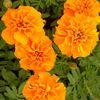
|
MarigoldBotanical Name: Tagetes erecta 'Janie'
Janie Marigold (Tagetes erecta 'Janie') is a compact, heat-tolerant annual prized for its dense, double blooms in bright yellow, orange, and gold hues. This variety is well-suited for seasonal beds, borders, and container plantings, offering long-lasting color from late spring through fall. The Janie series is specially bred for dwarf growth and prolific flowering, making it an ideal choice for gardeners seeking low-maintenance color in warm climates. Marigolds thrive in full sun and well-draining soil, preferring neutral to slightly acidic conditions. They are highly drought tolerant once established, though regular watering encourages maximum bloom production. Deer and rabbit resistant, marigolds also help repel certain garden pests, making them useful as companion plants in vegetable gardens. Janie Marigolds grow to a mature height of 8-12 inches with a spread of 6-10 inches, forming dense, bushy plants covered in blooms. When planting in groups, spacing of 6-10 inches apart ensures full, even coverage. Compared to taller marigold varieties, the Janie series remains compact and uniform, making it a reliable choice for smaller spaces or edging walkways. In USDA Zones 9-11, marigolds may reseed and return the following year, though they are commonly grown as annuals in Texas landscapes. Removing spent flowers (deadheading) can prolong blooming, keeping gardens vibrant well into the fall. Their ability to withstand heat and poor soil conditions makes them one of the most versatile flowering annuals for warm climates.
[ More Info ]
|
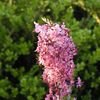
|
Mexican BuckeyeBotanical Name: Ungnadia speciosa
Mexican Buckeye (Ungnadia speciosa) is a small, deciduous Texas native tree or large shrub appreciated for its light pink, fragrant blooms in early spring and its adaptability to a wide range of soil and weather conditions. It is commonly used in wildlife gardens, understory plantings, or as a small ornamental tree in drought-prone areas of Central and West Texas. This species thrives in full sun to partial shade and grows best in well-drained soil, showing a strong tolerance for alkaline soils and poor rocky conditions. It is highly drought-tolerant once established and deer-resistant, making it a reliable performer in dry landscapes. The seeds are contained in hard, glossy brown pods that rattle when shaken—an appealing feature in naturalistic gardens. Mexican Buckeye typically reaches 10 to 15 feet in height and width, forming a rounded, multi-trunked shape. When planting in groups, allow 8 to 12 feet of spacing. In addition to its attractive flowers and pods, it develops yellow fall color, offering seasonal interest beyond its spring bloom. While sometimes confused with Red Buckeye (Aesculus pavia), Mexican Buckeye is not botanically related. Red Buckeye has red flowers, larger leaves, and prefers slightly more moisture, whereas Mexican Buckeye has pink flowers, smoother leaf texture, and greater drought tolerance. Additionally, their seed pods are shaped differently, and Mexican Buckeye's bark is lighter and smoother. In USDA Zones 7–9, Mexican Buckeye is cold-hardy and typically requires no special winter protection. It responds well to light pruning in winter to maintain its shape or open up its structure. [ More Info ]
|

|
Mexican OreganoBotanical Name: Poliomintha longiflora
Semi-evergreen perennial with purple tubular flowers from early summer to fall. Peforms well in hot and dry Texas summers, blooming more profusely with regular pruning and if grown in full sun. Foliage can be used in cooking - a bit more kick than regular Oregano. No serious pest and disease issues, best grown in well draining soils and full sun. [ More Info ]
|

|
Miscellanous Item #1Botanical Name: Miscellanous Plant
Mortellaro's Nursery will at times have some miscellanous plants around the nursery to sell, and this page is simply a place holder for one of those plants. Assume these plants are of limited quantity, and will not be sold in the future. This page will NOT be updated with information about this plant, you will only see the name of the plant below if it is in stock, and what size, and what price (if you are logged in) [ More Info ]
|

|
Miscellanous Item #10Botanical Name: Miscellanous Plant
Mortellaro's Nursery will at times have some miscellanous plants around the nursery to sell, and this page is simply a place holder for one of those plants. Assume these plants are of limited quantity, and will not be sold in the future. This page will NOT be updated with information about this plant, you will only see the name of the plant below if it is in stock, and what size, and what price (if you are logged in) [ More Info ]
|

|
Miscellanous Item #11Botanical Name: Miscellanous Plant
Mortellaro's Nursery will at times have some miscellanous plants around the nursery to sell, and this page is simply a place holder for one of those plants. Assume these plants are of limited quantity, and will not be sold in the future. This page will NOT be updated with information about this plant, you will only see the name of the plant below if it is in stock, and what size, and what price (if you are logged in) [ More Info ]
|

|
Miscellanous Item #12Botanical Name: Miscellanous Plant
Mortellaro's Nursery will at times have some miscellanous plants around the nursery to sell, and this page is simply a place holder for one of those plants. Assume these plants are of limited quantity, and will not be sold in the future. This page will NOT be updated with information about this plant, you will only see the name of the plant below if it is in stock, and what size, and what price (if you are logged in) [ More Info ]
|

|
Miscellanous Item #13Botanical Name: Miscellanous Plant
Mortellaro's Nursery will at times have some miscellanous plants around the nursery to sell, and this page is simply a place holder for one of those plants. Assume these plants are of limited quantity, and will not be sold in the future. This page will NOT be updated with information about this plant, you will only see the name of the plant below if it is in stock, and what size, and what price (if you are logged in) [ More Info ]
|

|
Miscellanous Item #14Botanical Name: Miscellanous Plant
Mortellaro's Nursery will at times have some miscellanous plants around the nursery to sell, and this page is simply a place holder for one of those plants. Assume these plants are of limited quantity, and will not be sold in the future. This page will NOT be updated with information about this plant, you will only see the name of the plant below if it is in stock, and what size, and what price (if you are logged in) [ More Info ]
|

|
Miscellanous Item #15Botanical Name: Miscellanous Plant
Mortellaro's Nursery will at times have some miscellanous plants around the nursery to sell, and this page is simply a place holder for one of those plants. Assume these plants are of limited quantity, and will not be sold in the future. This page will NOT be updated with information about this plant, you will only see the name of the plant below if it is in stock, and what size, and what price (if you are logged in) [ More Info ]
|

|
Miscellanous Item #2Botanical Name: Miscellanous Plant
Mortellaro's Nursery will at times have some miscellanous plants around the nursery to sell, and this page is simply a place holder for one of those plants. Assume these plants are of limited quantity, and will not be sold in the future. This page will NOT be updated with information about this plant, you will only see the name of the plant below if it is in stock, and what size, and what price (if you are logged in) [ More Info ]
|

|
Miscellanous Item #3Botanical Name: Miscellanous Plant
Mortellaro's Nursery will at times have some miscellanous plants around the nursery to sell, and this page is simply a place holder for one of those plants. Assume these plants are of limited quantity, and will not be sold in the future. This page will NOT be updated with information about this plant, you will only see the name of the plant below if it is in stock, and what size, and what price (if you are logged in) [ More Info ]
|

|
Miscellanous Item #4Botanical Name: Miscellanous Plant
Mortellaro's Nursery will at times have some miscellanous plants around the nursery to sell, and this page is simply a place holder for one of those plants. Assume these plants are of limited quantity, and will not be sold in the future. This page will NOT be updated with information about this plant, you will only see the name of the plant below if it is in stock, and what size, and what price (if you are logged in) [ More Info ]
|

|
Miscellanous Item #5Botanical Name: Miscellanous Plant
Mortellaro's Nursery will at times have some miscellanous plants around the nursery to sell, and this page is simply a place holder for one of those plants. Assume these plants are of limited quantity, and will not be sold in the future. This page will NOT be updated with information about this plant, you will only see the name of the plant below if it is in stock, and what size, and what price (if you are logged in) [ More Info ]
|

|
Miscellanous Item #6Botanical Name: Miscellanous Plant
Mortellaro's Nursery will at times have some miscellanous plants around the nursery to sell, and this page is simply a place holder for one of those plants. Assume these plants are of limited quantity, and will not be sold in the future. This page will NOT be updated with information about this plant, you will only see the name of the plant below if it is in stock, and what size, and what price (if you are logged in) [ More Info ]
|

|
Miscellanous Item #7Botanical Name: Miscellanous Plant
Mortellaro's Nursery will at times have some miscellanous plants around the nursery to sell, and this page is simply a place holder for one of those plants. Assume these plants are of limited quantity, and will not be sold in the future. This page will NOT be updated with information about this plant, you will only see the name of the plant below if it is in stock, and what size, and what price (if you are logged in) [ More Info ]
|

|
Miscellanous Item #8Botanical Name: Miscellanous Plant
Mortellaro's Nursery will at times have some miscellanous plants around the nursery to sell, and this page is simply a place holder for one of those plants. Assume these plants are of limited quantity, and will not be sold in the future. This page will NOT be updated with information about this plant, you will only see the name of the plant below if it is in stock, and what size, and what price (if you are logged in) [ More Info ]
|

|
Miscellanous Item #9Botanical Name: Miscellanous Plant
Mortellaro's Nursery will at times have some miscellanous plants around the nursery to sell, and this page is simply a place holder for one of those plants. Assume these plants are of limited quantity, and will not be sold in the future. This page will NOT be updated with information about this plant, you will only see the name of the plant below if it is in stock, and what size, and what price (if you are logged in) [ More Info ]
|
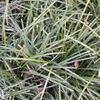
|
Monkey GrassBotanical Name: Ophiopogon japonicus
Monkey Grass, also known as Mondo Grass (which can easily by confused with Dwarf Monkey Grass) is a versatile, low-maintenance groundcover suitable for Texas landscapes. This herbaceous perennial thrives in USDA Zones 6 through 11 and is well-suited for a wide range of soil types, preferring well-drained, slightly acidic to neutral soils. Though not a Texas native, it is highly adaptable and performs well in shaded areas, tolerating part sun with adequate moisture. Its fine-textured, grass-like foliage creates a lush, uniform appearance, making it an excellent choice for borders, underplanting around trees, or as a lawn alternative in low-traffic areas. Monkey Grass is non-toxic, making it safe for households with pets or children, and it is resistant to deer browsing, adding to its value in Texas gardens. While it does not tolerate prolonged drought, it is moderately drought-tolerant once established, making it ideal for shaded gardens or areas with limited direct sunlight. Reaching a mature height of 6 to 12 inches and spreading slowly through underground rhizomes, Monkey Grass is perfect for filling in small spaces or creating a tidy edge along paths and walkways. Space plants 6 to 10 inches apart for a dense, even coverage. This plant produces small spikes of lavender or white flowers in late summer, followed by dark blue to black berries, adding subtle ornamental interest. Monkey Grass is prized for its year-round evergreen foliage, providing texture and greenery even in winter. Winter care for Monkey Grass is minimal in Texas climates. In colder regions or after frost, the foliage may brown slightly but will rebound in spring. Trimming back old leaves in late winter encourages fresh growth and maintains its neat appearance. [ More Info ]
|
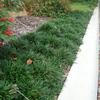
|
Monkey Grass, DwarfBotanical Name: Ophiopogon japonicus 'Nana'
Dwarf Monkey Grass (Ophiopogon japonicus ‘Nana’), a compact variety of Mondo Grass, is a hardy, low-maintenance groundcover perfect for Texas landscapes. Thriving in USDA Zones 6 through 11, this herbaceous perennial prefers well-drained, slightly acidic to neutral soils and is highly adaptable to a range of conditions. Though not a Texas native, it is an excellent choice for shaded or part-sun areas, withstanding the Texas heat when protected from harsh afternoon sun. Its dense, fine-textured foliage grows in clumps, making it an ideal choice for borders, rock gardens, or as an edging plant along paths and beds. Dwarf Monkey Grass is non-toxic and safe for households with pets and children, and its foliage is resistant to deer browsing. This variety is slower-growing and more compact than standard Monkey Grass, reaching a mature height of just 3 to 6 inches with a spread of 6 to 12 inches. For uniform coverage, space plants 4 to 6 inches apart. It requires minimal water once established, making it a reliable choice for shaded gardens or water-wise landscaping. While it rarely blooms, Dwarf Monkey Grass may produce small lavender or white flowers in late summer, followed by dark berries. Its year-round evergreen foliage adds texture and greenery to any landscape, maintaining its aesthetic appeal even during the winter months. Winter care is straightforward for Dwarf Monkey Grass. In colder regions, the foliage may brown slightly after frost but will recover in spring. Trimming back old or damaged leaves in late winter helps refresh its appearance and encourages healthy new growth. [ More Info ]
|

|
Moss RoseBotanical Name: Portulaca grandiflora
Portulaca, also known as Moss Rose and even Purslane, is a low-growing, heat-loving annual known for its vibrant, semi-double blooms in shades of pink, yellow, red, orange, and white. This fast-spreading groundcover thrives in hot, dry conditions, making it an excellent choice for Texas landscapes, rock gardens, and container plantings. Blooming from spring through fall, it provides continuous color with minimal care. This Portulaca variety prefers full sun and well-draining soil, tolerating both acidic and alkaline conditions. It is exceptionally drought-tolerant, requiring only occasional watering once established. The succulent-like foliage helps retain moisture, making it ideal for xeriscaping and areas with poor soil. It is deer-resistant and attracts pollinators like butterflies. Reaching a mature size of 6-8 inches tall and spreading up to 12-18 inches wide, Portulaca is perfect for mass plantings, edging, and filling in gaps between stepping stones. When planting in clusters, space plants 10-12 inches apart to allow for full coverage. While not known for reliable reseeding, it may self-sow in warm climates. As an annual in USDA Zones 2-11, it thrives throughout the warm season but does not survive hard frosts. In cooler regions, it can be grown in containers and overwintered indoors if desired. No winter care is needed for replanting in spring. Cultivars 2025 Happy Hour TM Mix [ More Info ]
|
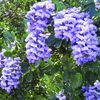
|
Mountain LaurelBotanical Name: Dermatophyllum secundiflorum
Extremely popular native found throughout the southern half of Texas. Naturally grows as a multi-trunked shrub or small tree with fragrant spring blooms. Texas Mountain Laurel is a slow growing evergreen that absolutely requires adequate drainage. Being native to rocky limestone areas, roots are not as robust and wide-growing as other trees, making container transplanting a cautious process. The dark green compound leaves can have up to 9 leaflets, and cast a reasonable shade underneath that allows some under planting. Naturally grows as a multi-trunked shrub, however can be trimmed into a small tree form. Very drought tolerant once established. Large pendulous clusters of violet-lavender blooms appear early in the spring, reaching up to 10 inches in length. The smell is notably that of grape-koolaid, and sadly they only last for two to three weeks. Legume seed pods contain bright red to orange seeds with a very resilient seed coat – it could take years for germination to naturally occur! The cotyledon (white part inside the seed) inside is highly toxic, however not easily digested if the seed coat is fresh. Mountain Laurel does fine without regular maintenance, however appreciates spring fertilization. [ More Info ]
|
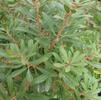
|
Myrtle, Southern WaxBotanical Name: Myrica cerifera
Native to the east Texas wetlands, Southern Wax Myrtle easily adapts to poorer soils, hot and dry conditions, and salty areas. It is a multi-trunked large shrub or small tree, spreading easily with an extensive underground root system. Naturally forms an open, irregular form, but responds well to pruning into a formed hedge or bonsai habit. Wax Myrtle is dioecious; males display small yellow-green catkins up to an inch long in the early spring, while in the late summer females have small inconspicuous flowers followed by small blue berries. The lime green leaves can be up to four inches long but only half an inch wide and are slightly aromatic when bruised. Small yellow glands are on the leaves, sometimes mistakened for a pest or disease. A dwarf cultivar, ‘Nana’, reaches only five feet high and wide. [ More Info ]
|
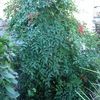
|
Nandina, CompactBotanical Name: Nandina domestica 'Compacta'
The bright green stems and branching habit of the Nandina earned it the name Heavenly Bamboo, however it does not belong in the same plant family. Native to China and Japan, Nandina is a semi-evergreen plant species with several cultivars that allow it to fill several roles in the landscape. ‘Compacta’ is a cultivar that only reaches 4 feet in height, making it more manageable in smaller landscapes. The distinctive compound leaves have several leaflets that grow out on non-branching stems. Nearly all species of Nandina spread outward with underground rhizomes that will give the Nandina clumping form over time. New foliage in the spring has a light red tint, turning green in the summer before turning red to red-bronze in the fall and winter. Large panicles of small white flowers appear on the ends of stems in the late spring, forming multitude of red-orange berries that provide handsome color in late summer and into winter. Birds seek the berries out for food in the winter, however they are mildly toxic to pets and livestock. All Nandina species are highly tolerant of poor soil condition and quality, as long as it’s given adequate drainage and not sand; when given at least mediocre care, it’s also highly pest and disease resistant. It is an ideal plant for rarely maintained landscapes. [ More Info ]
|
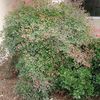
|
Nandina, DomesticBotanical Name: Nandina domestica
The bright green stems and branching habit of the Nandina earned it the name Heavenly Bamboo, however it does not belong in the same plant family. Native to China and Japan, Nandina is a semi-evergreen plant species with several cultivars that allow it to fill several roles in the landscape. The distinctive compound leaves have several leaflets that grow out on non-branching stems. Nearly all species of Nandina spread outward with underground rhizomes that will give the Nandina clumping form over time. New foliage in the spring has a light red tint, turning green in the summer before turning red to red-bronze in the fall and winter. Large panicles of small white flowers appear on the ends of stems in the late spring, forming multitude of red-orange berries that provide handsome color in late summer and into winter. Birds seek the berries out for food in the winter, however they are mildly toxic to pets and livestock. All Nandina species are highly tolerant of poor soil condition and quality, as long as it’s given adequate drainage and not sand; when given at least mediocre care, it’s also highly pest and disease resistant. It is an ideal plant for rarely maintained landscapes. [ More Info ]
|
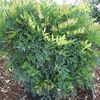
|
Nandina, GulfstreamBotanical Name: Nandina domestica 'Gulfstream'
The bright green stems and branching habit of the Nandina earned it the name Heavenly Bamboo, however it does not belong in the same plant family. Native to China and Japan, Nandina is a semi-evergreen plant species with several cultivars that allow it to fill several roles in the landscape. ‘Gulfstream’ is a cultivar from Hine’s Horticulture Inc. that is more compact and symmetrical in growth habit, making it the most manageable compact Nandina. The distinctive compound leaves have several leaflets that grow out on non-branching stems. ‘Gulfstream’ Nandina does not spread outward with underground rhizomes. New foliage in the spring has a flush of red color, turning blue-green in the summer before turning red-bronze in the fall and winter. ‘Gulfstream’ does not bloom heavily, and seldom sets berries. All Nandina species are highly tolerant of poor soil condition and quality, as long as it’s given adequate drainage and not sand; when given at least mediocre care, it’s also highly pest and disease resistant. It is an ideal plant for rarely maintained landscapes. [ More Info ]
|
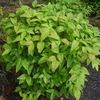
|
Nandina, NanaBotanical Name: Nandina domestica 'Nana Atropurpurea'
The bright green stems and branching habit of the Nandina earned it the name Heavenly Bamboo, however it does not belong in the same plant family. Native to China and Japan, Nandina is a semi-evergreen plant species with several cultivars that allow it to fill several roles in the landscape. ‘Nana’ is a very compact cultivar with a spherical growth habit. The distinctive compound leaves have several leaflets that grow out on non-branching stems. New foliage in the spring has a flush of bright green, turning bright yellow-green in the summer before turning crimson-red in the fall and winter. Rarely blooms and produces berries. All Nandina species are highly tolerant of poor soil condition and quality, as long as it’s given adequate drainage and not sand; when given at least mediocre care, it’s also highly pest and disease resistant. It is an ideal plant for rarely maintained landscapes. [ More Info ]
|
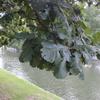
|
Oak, BurBotanical Name: Quercus macrocarpa
Bur Oak (also spelled Burr) is the most cold and drought tolerant of the oaks, able to thriveas far north as Alaska. A white oak, Bur Oak is a slow growing deciduous tree, averaging one foot per season. Naturally forms a wide open crown, growing wider than tall in the landscape, only starting to be taller than wide after reaching heights over 50 feet. The deeply ridged bar is ash-gray to dark brown in color, with fissures getting deeper with age. Leaves can grow up to nine inches in length, narrow but with deep lobes at the base, becoming much wider at the end. Bur Oak is monoecious, and blooms right after the leaves appear in the spring; yellow-green male catkins are up to four inches long, while female flowers are green and appear in short single spikes. The largest acorns of the oaks follow shortly thereafter – measuring up to two inches across. They are enclosed in a large cap with overlapping scales and sport an attractive fringe; it looks very much like the bur of a chestnut, giving this oak its name. Avoid planting Bur Oak in parking lots, as the acorns can damage vehicles. [ More Info ]
|
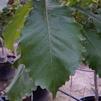
|
Oak, ChinquapinBotanical Name: Quercus muehlenbergii
Chinquapin (or chinkapin) oak is a white oak reaching heights of 70 feet while developing a natural round crown. Native to central Texas along the Guadalupe River, it tolerates limestone soils very well. The simple elliptical leaves have a sharp toothed pattern with no bristles, making it easily distinguishable amoungst other oaks. Yellowish catkin blooms cover the male trees in the spring, and can be a nuisance if planted near swimming pools. The acorns are some of the sweetest of all oaks, and can be eaten after being roasted. [ More Info ]
|
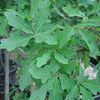
|
Oak, LaceyBotanical Name: Quercus laceyi
Native to central and south Texas, the Lacey Oak is known by many names – Quercus glaucoides, Blue Oak Canyon Oak, Encino Oak, Mountain Oak, Smokey Oak, or Rock Oak. It was previously awarded the title of a Texas Superstar for its wide tolerance of soil types (as long as well drained) and conditions and ease of transition into any Texas landscape. New foliage is slightly pubescent and peach colored, turning blue-green in the summer and brown to yellow in the fall. They are thicker to the touch than other oak leaves, and have shallow lobes. The tree exhibits an upright branching habit, and when grown in the wild can produce multiple trunks; nursery stock is often pruned for single trunk. Forms an irregular round crown, with shallow furrows and scaled ridged bark. Maturing at 35 feet, Lacey Oak is an ideal shade tree for the small backyard. [ More Info ]
|
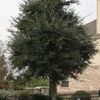
|
Oak, LiveBotanical Name: Quercus virginiana
Live Oak is not only a predominate icon of the Southern landscape, but a popular addition to many landscapes thanks to being fast growing, highly durable, and its longevity. It’s also resistant to salt spray, drought, and poor soil qualities. They are highly attractive found growing horizontally along the ground before reaching upward, however nearly all landscapers and homeowners choose a single, upright trunked specimen. Live Oak can also host other plants on its trunk and branches: ball moss, Spanish moss, mistletoe, and resurrection fern. Although Live Oak is evergreen, it will heavily defoliate in the late winter when new foliage begins to emerge. Leaves are stiff and leathery, shiny dark green on top and pale gray on the underside. Green catkin flowers up to four inches in length appear in the spring, dumping pollen that is easily spread by the wind. Acorns vary in size, averaging one inch in length and are tan-brown until turning black in the fall. The dark brown to black bark is thick and slightly furrowed, forming large alligator-scale bark plates as it ages. The wood is some of the heaviest of the oak family, commonly used for carpentry, fuel, and grilling. Sprouts from the roots can become a nuisance; dense saplings can surround the main trunk, requiring constant pruning if you wish to avoid a clump of trees. A fungus has also been identified as the culprit in oak wilt disease, killing many live oaks that have grown in the countryside throughout Texas. [ More Info ]
|
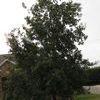
|
Oak, MexicanBotanical Name: Quercus polymorpha
The Mexican Oak, also known as Monterrey Oak, is a versatile and resilient tree well-suited for Texas landscapes. This semi-evergreen species is known for retaining much of its foliage through winter, typically dropping 50-75% of its leaves in early spring just before new growth emerges. This results in many concerned homeowners that think something may be wrong with the tree, however we like to consider the Mexican Oak the “burlesque dancer” of the oak family – graceful, unique, and a little unconventional in its timing. The leaves themselves can be unconventional in a sense, as they vary from tree to tree. This is one reason the scientific name is “polymorpha”. The texture is always the same, but shape and lobe depth varies tree to tree. While a mature height of 80 feet is possible, it will average 60 feet in a normal landscape. It serves as an excellent shade tree for large properties, parks, or open spaces. As a member of the white oak group, the Mexican Oak is highly resistant to Oak Wilt, a devastating disease that affects many other oak species in Texas. This resistance makes it an excellent choice for areas where Oak Wilt is a concern. Its adaptability to various soil types, including rocky or alkaline soils, and its tolerance to heat and drought make it particularly well-suited for Texas's challenging climate conditions. The tree thrives in full sun and requires minimal maintenance once established, making it a favorite among landscapers and homeowners alike. The Mexican Oak is not only functional but also aesthetically appealing, with a dense, rounded canopy that provides excellent shade. Its semi-evergreen nature ensures year-round visual interest, while its sturdy growth habit makes it highly durable against wind and storms. Whether used as a specimen tree or in group plantings, the Mexican Oak offers a combination of beauty, disease resistance, and environmental adaptability, making it a standout choice for Texas landscapes. [ More Info ]
|
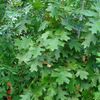
|
Oak, RedBotanical Name: Quercus shumardii
Texas native Shumard Oak is commonly found along creeks and swamps where it prefers moist well-drained soils. Reaching heights over 100 feet and up to 60 feet in width, forming a broad pyramidal crown; it is one of the largest red oaks available, so plant with consideration. New growth is light grey and very smooth. With age, the trunk and branches begin to darken, developing ridges and becoming only slightly furrowed. The broad leaves are lobbed with distinctive points, growing up to eight inches in length. They are dark green on top, light green on the bottom, and turn shades of yellow, red and brown in the fall. Under late summer heat stress or drought conditions, leaves will die and fall premature. Acorns are up to one inch in diameter, but take up to three years to fully mature; they are common food source for birds, squirrels, and deer. [ More Info ]
|
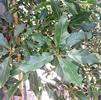
|
Oak, SierraBotanical Name: Quercus canbyi
Sierra Oak, a red oak, naturally grows in a pyramidal shape while it is young, developing a broader canopy after several years. With a mature size of 30 feet tall, it is an idea oak tree for the medium sized Texas landscape, and can grow in any area throughout Texas. Although it's classified as an evergreen, it will shed a majority of its leaves in the late winter much like Live or Mexican Oak. New foliage is red before turning a rich green color, turning red again in the fall. Laves are up to three inches long, and resemble a holly leaf. [ More Info ]
|
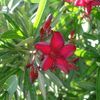
|
Oleander, DwarfBotanical Name: Nerium oleander 'cv.'
Oleander is a popular evergreen blooming landscape shrub that presumably originated from Asia; in the genus Nerium, it is the only species with over 400 cultivars accounted for. A popular choice due to its rapid growth habit, marvelous blooms, and tolerance to drought and poor soils. Oleander sends out large erect stems outward from its base in every direction. The leaves are arranged in whorls around the branches, bright to dark green, thick and leathery reaching up to six inches in length. The dwarf cultivars leaves are slightly smaller, and overall the plant matures at five feet. Every spring, clusters of flowers up to one and a half inches in diameter emerge on the tips of new branches, persisting for several weeks, and then continue to emerge sporadically throughout the season. The fruits that follow are long narrow capsules that contain numerous seeds. Oleander is one of the most poisonous landscape plants available – every part of the plant is toxic. Lately, it has had serious issues with bacterial blight, which is easily cultivated in areas without good air circulation or high moisture. The first stages result in black and brown spots on the leaves, followed by total defoliation of stems. Once canker growths are forming on the stems, it’s too late to try and save. The bacteria will remain in the soil, so any new oleanders that are planted there will surely get the disease again. [ More Info ]
|
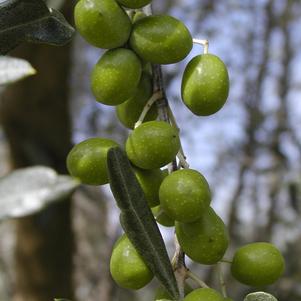
|
Olive, ArbequinaBotanical Name: Olea europaea 'Arberquina'
Native to the Mediterranean, Olive trees have quickly found their place in the Texas landscape. They are utilized for their hardiness with the weather, tolerance to poor soils, and manageable size. Some of the olive trees overseas are known to be over 1,000 years old. The Olive tree often has multiple trunks, however often trained to have a single trunk; if it severely damaged or cut down, new trunks will emerge from the roots. The grey-green leaves are thick and leathery, with stomata on the undersides that aid in water conservation. Flower buds are borne on the axils of leaves, often budding up a year before they open. The inflorescences average 15 to 30 flowers, but are often inconspicuous, but with a slight fragrance. The drupe olive fruits start green, and turn black when they ripen in the fall. It is commonly believed they are toxic, however they are simply extremely bitter and often get cured before being eaten. 'Arberquina' is from Spain. [ More Info ]
|
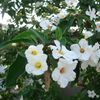
|
Olive, MexicanBotanical Name: Cordia boissieri
The Mexican Olive is native to southern areas of Texas, but will not grow north of Austin due to its low tolerance to freezing temperatures. A large shrub that is easily pruned into small tree form, it averages twenty feet high, making it ideal for small landscape areas. It is also drought tolerance once established, and tolerates any quality of soil as long as it’s adequately drained. Soft, dark-green leaves are a wonderfull backdrop to the clusters of showy white trumpet-shaped flowers that appear throughout the spring and summer. The fleshy fruits that follow feed the birds, deer, and cattle that find them, but they are slightly toxic and not for us to eat. Pest and disease free, Texas Olive’s only real issue is tenderness to freeze damage; it can recover from a light freeze, but only waiting till the growth comes back in the summer will you be able to tell if it didn’t make it. [ More Info ]
|
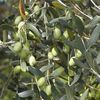
|
Olive, MissionBotanical Name: Olea europaea 'Mission'
Native to the Mediterranean, Olive trees have quickly found their place in the Texas landscape. They are utilized for their hardiness with the weather, tolerance to poor soils, and manageable size. Some of the olive trees overseas are known to be over 1,000 years old. The Olive tree often has multiple trunks, however often trained to have a single trunk; if it severely damaged or cut down, new trunks will emerge from the roots. The grey-green leaves are thick and leathery, with stomata on the undersides that aid in water conservation. Flower buds are borne on the axils of leaves, often budding up a year before they open. The inflorescences average 15 to 30 flowers, but are often inconspicuous, but with a slight fragrance. The drupe olive fruits start green, and turn black when they ripen in the fall. It is commonly believed they are toxic, however they are simply extremely bitter and often get cured before being eaten. [ More Info ]
|

|
Olive, Mission (Standard Form)Botanical Name: Olea europaea 'Mission'
Native to the Mediterranean, Olive trees have quickly found their place in the Texas landscape. They are utilized for their hardiness with the weather, tolerance to poor soils, and manageable size. Some of the olive trees overseas are known to be over 1,000 years old. The Olive tree often has multiple trunks, however often trained to have a single trunk; if it severely damaged or cut down, new trunks will emerge from the roots. The grey-green leaves are thick and leathery, with stomata on the undersides that aid in water conservation. Flower buds are borne on the axils of leaves, often budding up a year before they open. The inflorescences average 15 to 30 flowers, but are often inconspicuous, but with a slight fragrance. The drupe olive fruits start green, and turn black when they ripen in the fall. It is commonly believed they are toxic, however they are simply extremely bitter and often get cured before being eaten. [ More Info ]
|
